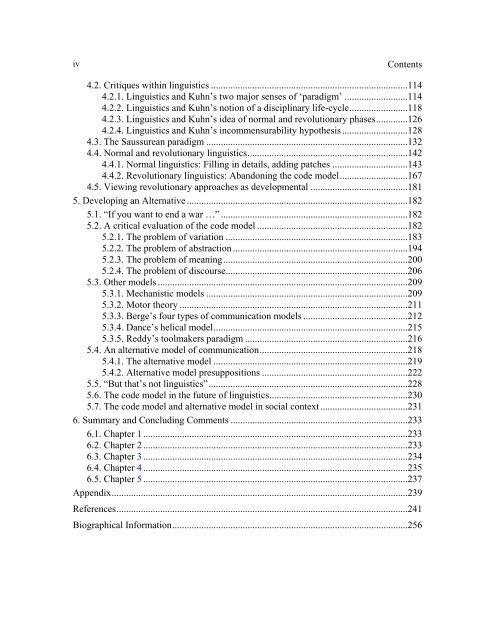The code model of communication: a powerful - SIL International
The code model of communication: a powerful - SIL International
The code model of communication: a powerful - SIL International
You also want an ePaper? Increase the reach of your titles
YUMPU automatically turns print PDFs into web optimized ePapers that Google loves.
iv<br />
Contents<br />
4.2. Critiques within linguistics .................................................................................114<br />
4.2.1. Linguistics and Kuhn’s two major senses <strong>of</strong> ‘paradigm’ ..........................114<br />
4.2.2. Linguistics and Kuhn’s notion <strong>of</strong> a disciplinary life-cycle........................118<br />
4.2.3. Linguistics and Kuhn’s idea <strong>of</strong> normal and revolutionary phases.............126<br />
4.2.4. Linguistics and Kuhn’s incommensurability hypothesis...........................128<br />
4.3. <strong>The</strong> Saussurean paradigm ...................................................................................132<br />
4.4. Normal and revolutionary linguistics..................................................................142<br />
4.4.1. Normal linguistics: Filling in details, adding patches ...............................143<br />
4.4.2. Revolutionary linguistics: Abandoning the <strong>code</strong> <strong>model</strong>............................167<br />
4.5. Viewing revolutionary approaches as developmental ........................................181<br />
5. Developing an Alternative ...........................................................................................182<br />
5.1. “If you want to end a war …” .............................................................................182<br />
5.2. A critical evaluation <strong>of</strong> the <strong>code</strong> <strong>model</strong> ..............................................................182<br />
5.2.1. <strong>The</strong> problem <strong>of</strong> variation ...........................................................................183<br />
5.2.2. <strong>The</strong> problem <strong>of</strong> abstraction ........................................................................194<br />
5.2.3. <strong>The</strong> problem <strong>of</strong> meaning............................................................................200<br />
5.2.4. <strong>The</strong> problem <strong>of</strong> discourse...........................................................................206<br />
5.3. Other <strong>model</strong>s .......................................................................................................209<br />
5.3.1. Mechanistic <strong>model</strong>s ...................................................................................209<br />
5.3.2. Motor theory ..............................................................................................211<br />
5.3.3. Berge’s four types <strong>of</strong> <strong>communication</strong> <strong>model</strong>s ...........................................212<br />
5.3.4. Dance’s helical <strong>model</strong>................................................................................215<br />
5.3.5. Reddy’s toolmakers paradigm ...................................................................216<br />
5.4. An alternative <strong>model</strong> <strong>of</strong> <strong>communication</strong>.............................................................218<br />
5.4.1. <strong>The</strong> alternative <strong>model</strong> ................................................................................219<br />
5.4.2. Alternative <strong>model</strong> presuppositions ............................................................222<br />
5.5. “But that’s not linguistics”..................................................................................228<br />
5.6. <strong>The</strong> <strong>code</strong> <strong>model</strong> in the future <strong>of</strong> linguistics.........................................................230<br />
5.7. <strong>The</strong> <strong>code</strong> <strong>model</strong> and alternative <strong>model</strong> in social context ....................................231<br />
6. Summary and Concluding Comments .........................................................................233<br />
6.1. Chapter 1 .............................................................................................................233<br />
6.2. Chapter 2 .............................................................................................................233<br />
6.3. Chapter 3 .............................................................................................................234<br />
6.4. Chapter 4 .............................................................................................................235<br />
6.5. Chapter 5 .............................................................................................................237<br />
Appendix..........................................................................................................................239<br />
References........................................................................................................................241<br />
Biographical Information.................................................................................................256

















